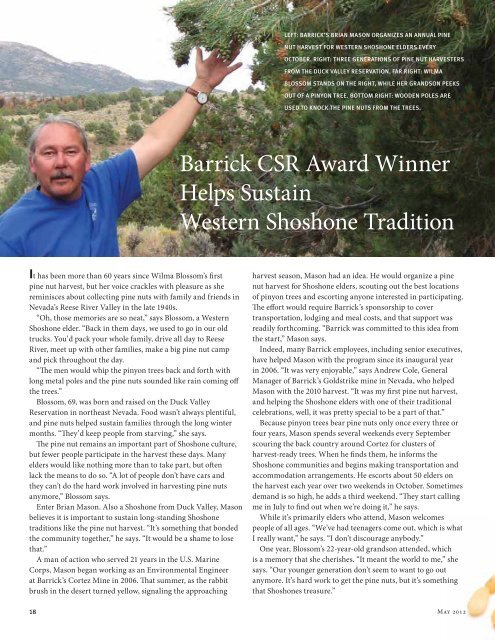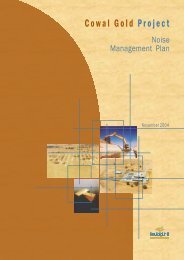Barrick Beyond Borders - May 2012 - Barrick Gold Corporation
Barrick Beyond Borders - May 2012 - Barrick Gold Corporation
Barrick Beyond Borders - May 2012 - Barrick Gold Corporation
You also want an ePaper? Increase the reach of your titles
YUMPU automatically turns print PDFs into web optimized ePapers that Google loves.
LEFT: BARRICK’S BRIAN MASON ORGANIZES AN ANNUAL PINENUT HARVEST FOR WESTERN SHOSHONE ELDERS EVERYOCTOBER. RIGHT: THREE GENERATIONS OF PINE NUT HARVESTERSFROM THE DUCK VALLEY RESERVATION. FAR RIGHT: WILMABLOSSOM STANDS ON THE RIGHT, WHILE HER GRANDSON PEEKSOUT OF A PINYON TREE. BOTTOM RIGHT: WOODEN POLES AREUSED TO KNOCK THE PINE NUTS FROM THE TREES.<strong>Barrick</strong> CSR Award WinnerHelps SustainWestern Shoshone TraditionIt has been more than 60 years since Wilma Blossom’s firstpine nut harvest, but her voice crackles with pleasure as shereminisces about collecting pine nuts with family and friends inNevada’s Reese River Valley in the late 1940s.“Oh, those memories are so neat,” says Blossom, a WesternShoshone elder. “Back in them days, we used to go in our oldtrucks. You’d pack your whole family, drive all day to ReeseRiver, meet up with other families, make a big pine nut campand pick throughout the day.“The men would whip the pinyon trees back and forth withlong metal poles and the pine nuts sounded like rain coming offthe trees.”Blossom, 69, was born and raised on the Duck ValleyReservation in northeast Nevada. Food wasn’t always plentiful,and pine nuts helped sustain families through the long wintermonths. “They’d keep people from starving,” she says.The pine nut remains an important part of Shoshone culture,but fewer people participate in the harvest these days. Manyelders would like nothing more than to take part, but oftenlack the means to do so. “A lot of people don’t have cars andthey can’t do the hard work involved in harvesting pine nutsanymore,” Blossom says.Enter Brian Mason. Also a Shoshone from Duck Valley, Masonbelieves it is important to sustain long-standing Shoshonetraditions like the pine nut harvest. “It’s something that bondedthe community together,” he says. “It would be a shame to losethat.”A man of action who served 21 years in the U.S. MarineCorps, Mason began working as an Environmental Engineerat <strong>Barrick</strong>’s Cortez Mine in 2006. That summer, as the rabbitbrush in the desert turned yellow, signaling the approachingharvest season, Mason had an idea. He would organize a pinenut harvest for Shoshone elders, scouting out the best locationsof pinyon trees and escorting anyone interested in participating.The effort would require <strong>Barrick</strong>’s sponsorship to covertransportation, lodging and meal costs, and that support wasreadily forthcoming. “<strong>Barrick</strong> was committed to this idea fromthe start,” Mason says.Indeed, many <strong>Barrick</strong> employees, including senior executives,have helped Mason with the program since its inaugural yearin 2006. “It was very enjoyable,” says Andrew Cole, GeneralManager of <strong>Barrick</strong>’s <strong>Gold</strong>strike mine in Nevada, who helpedMason with the 2010 harvest. “It was my first pine nut harvest,and helping the Shoshone elders with one of their traditionalcelebrations, well, it was pretty special to be a part of that.”Because pinyon trees bear pine nuts only once every three orfour years, Mason spends several weekends every Septemberscouring the back country around Cortez for clusters ofharvest-ready trees. When he finds them, he informs theShoshone communities and begins making transportation andaccommodation arrangements. He escorts about 50 elders onthe harvest each year over two weekends in October. Sometimesdemand is so high, he adds a third weekend. “They start callingme in July to find out when we’re doing it,” he says.While it’s primarily elders who attend, Mason welcomespeople of all ages. “We’ve had teenagers come out, which is whatI really want,” he says. “I don’t discourage anybody.”One year, Blossom’s 22-year-old grandson attended, whichis a memory that she cherishes. “It meant the world to me,” shesays. “Our younger generation don’t seem to want to go outanymore. It’s hard work to get the pine nuts, but it’s somethingthat Shoshones treasure.”18<strong>May</strong> <strong>2012</strong>
















